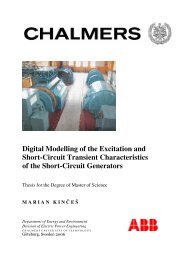Analysis of different topologies of multilevel inverters - webfiles its ...
Analysis of different topologies of multilevel inverters - webfiles its ...
Analysis of different topologies of multilevel inverters - webfiles its ...
You also want an ePaper? Increase the reach of your titles
YUMPU automatically turns print PDFs into web optimized ePapers that Google loves.
<strong>Analysis</strong> <strong>of</strong> <strong>different</strong> <strong>topologies</strong> <strong>of</strong> <strong>multilevel</strong><strong>inverters</strong>Master <strong>of</strong> Science ThesisMOHAMMADREZA DERAKHSHANFARDepartment <strong>of</strong> Energy and EnvironmentDivision <strong>of</strong> Electric Power EngineeringCHALMERS UNIVERSITY OF TECHNOLOGYGöteborg, Sweden, 2010I
<strong>Analysis</strong> <strong>of</strong> <strong>different</strong> inverter <strong>topologies</strong>Mohammadreza DerakhshanfarExaminer: Torbjörn ThiringerDepartment <strong>of</strong> Energy and EnvironmentDivision <strong>of</strong> Electric Power EngineeringChalmers University <strong>of</strong> TechnologySE-412 96 GöteborgSwedenTelephone +46 (0)31-772 1000II
AbstractThis thesis compares three <strong>different</strong> <strong>topologies</strong> <strong>of</strong> <strong>inverters</strong> (one level inverter, Diode clampedinverter, Flying capacitor clamped inverter and Cascaded H-bridge inverter). The <strong>multilevel</strong><strong>inverters</strong> are 5-level and 9-level <strong>inverters</strong>. This comparison is done with respect <strong>of</strong> powerlosses, cost, weight and THD. The switching pattern for <strong>inverters</strong> is explained as well. These<strong>inverters</strong> are connected to a 400V, 75kW asynchronous motor. For each inverter, IGBTs andMOSFETs are used as switching devices to make the comparisons more accurate. Theswitches that are used for <strong>different</strong> <strong>inverters</strong> are the same for all <strong>of</strong> the <strong>inverters</strong>. (There is nocontrol on inverter; also for loss calculation loading distribution is assumed.)If the THD is important, the 9-level <strong>inverters</strong> should be used, since it has a lower THD thanthe 5-level and the two-level inverter. The 9-level <strong>multilevel</strong> <strong>inverters</strong> have the lowest THDwhen filters are not used. Their THD is about 7%. If the cost is important the two-levelinverter should be used, since it has the lowest cost between all <strong>of</strong> the inverter <strong>topologies</strong>. Ifthe power losses are important, the 5-level diode clamped is the best choice since it has thelowest power losses between all other inverter <strong>topologies</strong>. If the weight is important the twolevelinverter is the best choice since it has the lowest weight between all other inverter<strong>topologies</strong>. Its weight is about 5Kg. If the power losses are important, the 5-level flyingcapacitor is the best choice, since it has the lower power losses between all the other inverter<strong>topologies</strong>. To select a <strong>multilevel</strong> inverter is a trade<strong>of</strong>f between cost, complexity, losses andTHD. The most important part is to decide which one is more important.I
AcknowledgmentsFirst and foremost I would like to express my gratitude to my examiner Pr<strong>of</strong>. TorbjörnThiringer for excellent supervision. This project would not be possible without his support.I also like to thank all <strong>of</strong> the staffs in the division <strong>of</strong> Electric power engineering for theirsupport.II
Table <strong>of</strong> ContentsAbstract .................................................................................................................................................... IAcknowledgments ................................................................................................................................... II1. Introduction ..................................................................................................................................... 11.1. HEV configurations ................................................................................................................. 11.1.1. Series configuration ......................................................................................................... 11.1.2. Parallel configuration ...................................................................................................... 11.1.3. Series-parallel configuration ........................................................................................... 21.2. Inverters ................................................................................................................................... 31.3. Purpose and goal ..................................................................................................................... 31.4. Previous works ........................................................................................................................ 42. Multilevel <strong>inverters</strong> ......................................................................................................................... 52.1. Diode Clamped <strong>multilevel</strong> inverter ......................................................................................... 52.1.1. 5-level diode clamped <strong>multilevel</strong> inverter ....................................................................... 52.1.2. 9-level diode clamped <strong>multilevel</strong> inverter ....................................................................... 72.2. Flying capacitor <strong>multilevel</strong> <strong>inverters</strong> ....................................................................................... 92.2.1. 5-level flying capacitor <strong>multilevel</strong> <strong>inverters</strong> .................................................................... 92.2.2. 9-level flying capacitor <strong>multilevel</strong> inverter ................................................................... 102.3. Cascaded H-bridge <strong>multilevel</strong> inverter .................................................................................. 112.3.1. 5-level Cascaded H-bridge <strong>multilevel</strong> inverter .............................................................. 112.3.2. 9-level cascaded H-bridge <strong>multilevel</strong> inverter ............................................................... 122.4. Harmonic elimination method ............................................................................................... 122.4.1. 5-level <strong>multilevel</strong> <strong>inverters</strong> ............................................................................................ 122.4.2. 9-level <strong>multilevel</strong> <strong>inverters</strong> ............................................................................................ 142.5. Power Losses calculations ..................................................................................................... 162.5.1. IGBT power losses calculations .................................................................................... 172.5.2. MOSFET power losses calculations .............................................................................. 183. Comparison between a 5-level diode clamped, flying capacitor, H-bridge and two-level <strong>inverters</strong>on Power losses, cost, weight and THD ................................................................................................ 203.1. Power Losses comparison between 5-level diode clamped, 5-level capacitor clamped, 5-level cascaded H-bridge and two-level <strong>inverters</strong> ............................................................................... 233.1.1. Loss calculations for IGBT FD300R06KE3 ................................................................. 233.1.2. Loss calculations for IGBT FF200R12KE4 .................................................................. 253.1.3. Loss calculations for IGBT FF200R12KE4 .................................................................. 27III
3.2. Power losses comparison between 9-level diode clamped <strong>multilevel</strong> inverter, 9-level flyingcapacitor clamped <strong>multilevel</strong> inverter and 9-level cascaded H-bridge <strong>multilevel</strong> inverter ............... 283.2.1. Loss calculations for IGBT FD300R06KE3 ................................................................. 283.2.2. Loss calculations for IGBT FF200R06KE4 .................................................................. 303.2.3. Power Losses calculations for Mosfet STE250NS10 .................................................... 323.3. Weight and cost comparisons ................................................................................................ 353.4. THD comparison for all <strong>of</strong> the inverter <strong>topologies</strong> ............................................................... 364. Conclusions ................................................................................................................................... 38References ............................................................................................................................................. 39IV
1. Introduction1.1. HEV configurationsA HEV is a vehicle that gets <strong>its</strong> propulsion energy from two <strong>different</strong> sources. One <strong>of</strong> themshould be electrical. There are <strong>different</strong> <strong>topologies</strong> to couple the power sources to the wheels:Series configuration, Parallel configuration, Series-parallel configuration.1.1.1. Series configurationThis configuration is the simplest variant <strong>of</strong> HEVs. The mechanical output <strong>of</strong> the internalcombustion engine is converted to electricity through a generator. The power that is producedby the generator can operate the electric motor or charge the battery. This configuration hasfour operation modes: 1. Acceleration: During the acceleration mode the internal combustionengine and the battery operate the motor. 2. Light load: In this mode the energy that isproduced by the internal combustion engine is more than the energy that is used by the motor,hence the extra power charges the battery. 3. Braking or deceleration: In this mode, the motoracts as a generator and charge the battery through the power converter. 4. Battery charging:The battery is charged by the internal combustion engine through the power converter whenthe vehicle is in complete stop. Fig. 1 shows the schematic <strong>of</strong> a series HEV configuration.Fuel TankEngineGeneratorTransmissionBatteryPowerConverterMotorFigure 1. Series HEV configuration (Yellow: hydraulic, Blue: Mechanical, Red: electrical)1.1.2. Parallel configurationIn this configuration, the engine and the motor are coupled to the transmission system, so theycan work separately. This configuration has four operation modes: 1. Acceleration: In thismode the electric motor and the internal combustion engine drive the wheels at the same time.Normally 80 percent <strong>of</strong> the energy is supplied by the internal combustion engine and 20percent is supplied by the electric motor. 2. Normal driving: In this mode, the electric motor is<strong>of</strong>f while the internal combustion engine runs the wheels. 3. Braking or deceleration: Duringthis operation mode the battery is charged through the power converter. 4. Battery charging:1
The battery is charged by the internal combustion engine since the engine and the electricmotor are coupled when the vehicle is in full stop. Fig. 2 shows the schematic <strong>of</strong> a parallelHEV configuration.Fuel TankEngineTransmissionBatteryPowerConverterMotorFigure 2. Parallel HEV configuration (Yellow: hydraulic, Blue: Mechanical, Red: electrical)1.1.3. Series-parallel configurationIn this configuration, a generator is added between the engine and the power converter. Thecontrol method in this configuration is more complicated than the series and the parallelconfigurations. The operating modes in this configuration is divided in two groups, electricheavywhere the electric motor is more active and engine-heavy where the internalcombustion engine is more active in the operation. The engine-heavy has six operationmodes: 1. Startup: In this mode the battery drives the wheels through the electric motor whilethe internal combustion engine is <strong>of</strong>f. 2. Acceleration: During the acceleration mode theinternal combustion engine and the electric motor run the wheels at the same time. 3. Normaldriving: The internal combustion engine drives the wheels while the electric motor is <strong>of</strong>f. 4.Deceleration: The electric motor charges the battery through the power converter. 5. Batterycharging in normal driving: In this mode the internal combustion engine should run thewheels and the generator at the same time to charge the battery. 6. Battery charging: Theinternal combustion engine charges the battery through the generator while the vehicle is infull stop. The electric-heavy has also six operation modes: 1. Startup: In this mode the batterydrives the wheels through the electric motor while the internal combustion engine is <strong>of</strong>f. 2.Acceleration: The internal combustion engine and the battery drive the wheels. 3. Normaldriving: The internal combustion engine and the battery drive the wheels. 4. Deceleration: Theelectric motor acts as a generator to charge the battery through the power converter. 5. Batterycharging in normal driving: The internal combustion engine should drive the wheels and thegenerator at the same time to charge the battery. 6. Battery charging: The internal combustionengine charges the battery through the generator and the power converter. Fig. 3 illustrates theschematic <strong>of</strong> a series-parallel HEV configuration.2
Fuel TankEngineGeneratorTransmissionBatteryPowerConverterMotorFigure 3. Series-parallel HEV configuration (Yellow: hydraulic, Blue: Mechanical, Red: electrical)1.2. InvertersThe power in the battery is in DC mode and the motor that drives the wheels usually uses ACpower, therefore there should be a conversion from DC to AC by a power converter. Inverterscan do this conversion. The simplest topology that can be used for this conversion is the twolevelinverter that consists <strong>of</strong> four switches. Each switch needs an anti-parallel diode, so thereshould be also four anti parallel diodes. There are also other <strong>topologies</strong> for <strong>inverters</strong>. A<strong>multilevel</strong> inverter is a power electronic system that synthesizes a sinusoidal voltage outputfrom several DC sources. These DC sources can be fuel cells, solar cells, ultra capacitors, etc.The main idea <strong>of</strong> <strong>multilevel</strong> <strong>inverters</strong> is to have a better sinusoidal voltage and current in theoutput by using switches in series. Since many switches are put in series the switching anglesare important in the <strong>multilevel</strong> <strong>inverters</strong> because all <strong>of</strong> the switches should be switched insuch a way that the output voltage and current have low harmonic distortion.Multilevel <strong>inverters</strong> have three types. Diode clamped <strong>multilevel</strong> <strong>inverters</strong>, flying capacitor<strong>multilevel</strong> <strong>inverters</strong> and cascaded H-bridge <strong>multilevel</strong> inverter.The THD will be decreased by increasing the number <strong>of</strong> levels. It is obvious that an outputvoltage with low THD is desirable, but increasing the number <strong>of</strong> levels needs more hardware,also the control will be more complicated. It is a trade<strong>of</strong>f between price, weight, complexityand a very good output voltage with lower THD.1.3. Purpose and goalThe purpose <strong>of</strong> this thesis is to compare the diode clamped <strong>multilevel</strong> inverter, the flyingcapacitor <strong>multilevel</strong> inverter, the cascaded H-bridge <strong>multilevel</strong> inverter and the two-levelinverter. These comparisons are done with respect to losses, cost, weight and THD. For thesecomparisons all <strong>of</strong> the <strong>inverters</strong> are simulated in MATLAB/SIMULINK. Moreover a goal isto compare three <strong>different</strong> switches for each type <strong>of</strong> inverter.3
1.4. Previous worksThe previous works that has been done on the <strong>multilevel</strong> <strong>inverters</strong> are more focused on theTHD and the switching pattern <strong>of</strong> the <strong>multilevel</strong> <strong>inverters</strong>. Most <strong>of</strong> them are focused on to geta better output voltage and current with lower THD by <strong>different</strong> switching patterns. Switchingangles in <strong>multilevel</strong> <strong>inverters</strong> are so important; since it can affect the output voltage andcurrent THD. There are many interesting works on calculating the switching angles toeliminate the lowest order harmonics, such as “Active Harmonic Elimination for MultilevelConverters” (Tolbert), which is a study <strong>of</strong> <strong>different</strong> harmonic elimination methods. Thenewest method that uses for harmonic elimination is resultant theory. “Eliminating harmonicsin a <strong>multilevel</strong> converter using resultant theory” (Chiasson) is more focused on the resultanttheory for calculating the switching angles. There are also some works that are focused on<strong>different</strong> usages <strong>of</strong> the <strong>multilevel</strong> <strong>inverters</strong>. There are some other works that are related to thisthesis that investigated <strong>different</strong> <strong>topologies</strong> <strong>of</strong> <strong>multilevel</strong> <strong>inverters</strong> for <strong>different</strong> electricapplications.”Multilevel converters for large electric drives” (Tolbert) compares the cascadedH-bridge <strong>multilevel</strong> <strong>inverters</strong> with diode clamped <strong>multilevel</strong> <strong>inverters</strong> for large electric drives.4
2. Multilevel <strong>inverters</strong>Three types <strong>of</strong> <strong>multilevel</strong> inverter have been investigated in this thesis.1. Diode Clamped <strong>multilevel</strong> <strong>inverters</strong>2. Flying Capacitor <strong>multilevel</strong> <strong>inverters</strong>3. Cascaded H-bridge <strong>multilevel</strong> <strong>inverters</strong>2.1. Diode Clamped <strong>multilevel</strong> inverterThe main concept <strong>of</strong> this inverter is to use diodes to limit the power devices voltage stress.The voltage over each capacitor and each switch is V dc . An n level inverter needs (n-1)voltage sources, 2(n-1) switching devices and (n-1) (n-2) diodes. 5-level diode clamped<strong>multilevel</strong> inverter2.1.1. 5-level diode clamped <strong>multilevel</strong> inverterIn a 5-level diode clamped <strong>multilevel</strong>:n=5Therefore:Number <strong>of</strong> switches=2(n-1) =8Number <strong>of</strong> diodes= (n-1) (n-2) =12Number <strong>of</strong> capacitors= (n-1) =4A 5-level diode clamped <strong>multilevel</strong> inverter is shown in Fig. 4. Switching states are shown inTable.1. For example to have V dc /2 in the output, switches S 1 to S4 should conduct at thesame time. For each voltage level four switches should conduct. As it can be seen in Table.1the maximum output voltage in the output is half <strong>of</strong> the DC source. It is a drawback <strong>of</strong> thediode clamped <strong>multilevel</strong> inverter. This problem can be solved by using a two times voltagesource or cascading two diode clamped <strong>multilevel</strong> <strong>inverters</strong>. The output voltage <strong>of</strong> a 5-leveldiode clamped <strong>multilevel</strong> inverter is shown in Fig.5. As can be seen in Fig.5 all <strong>of</strong> the voltagelevel should have the same voltage value.The switching angles should be calculated in such a way that the THD <strong>of</strong> the output voltagebecomes as low as possible. The switching angle calculation method that is used in this thesisis the harmonic elimination method. In this method the lower dominant harmonics can beeliminated by choosing calculated switching angles. This method will be explained later inthis thesis.5
Table 1. The switching states <strong>of</strong> Diode clamped <strong>multilevel</strong> inverter.V 0 S 1 S 2 S 3 S 4 S 5 S 6 S 7 S 8V dc /2 1 1 1 1 0 0 0 0V dc /4 0 1 1 1 1 0 0 00 0 0 1 1 1 1 0 0-V dc /4 0 0 0 1 1 1 1 0-V dc /2 0 0 0 0 1 1 1 1S 1C 1S 2S 3C 2S 4VS 5C 3S 6S 7C 4S 8Figure 4. One phase <strong>of</strong> a diode clamped inverter6
Voltage(V)4003002001000-100-200-300-4000 0.002 0.004 0.006 0.008 0.01 0.012 0.014 0.016 0.018 0.02time(seconds)Figure 5. Output voltage <strong>of</strong> a 5-level <strong>multilevel</strong> inverter2.1.2. 9-level diode clamped <strong>multilevel</strong> inverterIn this thesis a 9-level diode clamped inverter is made <strong>of</strong> two 5-level diode clamped <strong>inverters</strong>which are cascaded. Therefore the number <strong>of</strong> switches, diodes and capacitors are two timesmore than the 5-level diode clamped inverter. For a 9-level <strong>multilevel</strong> inverter:n=9Therefore:Number <strong>of</strong> switches=2(n-1) =16Number <strong>of</strong> diodes= (n-1) (n-2) =24Number <strong>of</strong> capacitors= (n-1) =8In this method switching angle should be calculated in such a way so that a 9-level outputvoltage is produced. The output voltages <strong>of</strong> each 5-level diode clamped <strong>multilevel</strong> inverter areadded to each other, and then the output voltage is created. The output voltage <strong>of</strong> each diodeclamped <strong>multilevel</strong> inverter is shown in Fig.6 and Fig.7.7
Voltage(V)Voltage(V)200150100500-50-100-150-2000 0.002 0.004 0.006 0.008 0.01 0.012 0.014 0.016 0.018 0.02time(seconds)Figure 6. Output voltage <strong>of</strong> the first cell200150100500-50-100-150-2000 0.002 0.004 0.006 0.008 0.01 0.012 0.014 0.016 0.018 0.02time(seconds)Figure 7. Output voltage <strong>of</strong> the second cell8
voltage(V)And by adding these output voltages to each other, there will be a 9-level output voltage as itis shown in Fig.8.4003002001000-100-200-300-4000 0.002 0.004 0.006 0.008 0.01 0.012 0.014 0.016 0.018 0.02time(seconds)Figure 8. Output voltage <strong>of</strong> a 9-level <strong>multilevel</strong> inverter2.2. Flying capacitor <strong>multilevel</strong> <strong>inverters</strong>This inverter uses capacitors to limit the voltage <strong>of</strong> the power devices. The configuration <strong>of</strong>the flying capacitor <strong>multilevel</strong> inverter is like a diode clamped <strong>multilevel</strong> inverter except thatcapacitors are used to divide the input DC voltage. The voltage over each capacitor and eachswitch is V dc .2.2.1. 5-level flying capacitor <strong>multilevel</strong> <strong>inverters</strong>For a 5-level flying capacitor <strong>multilevel</strong> inverter:n=5Therefore:Number <strong>of</strong> switches=8Number <strong>of</strong> capacitors= 10Fig. 9 shows a five level flying capacitor <strong>multilevel</strong> inverter. The switching states in thisinverter are like in the diode clamped <strong>multilevel</strong> inverter. It means that for each output voltagelevel 4 switches should be on. Table.2 shows the switching states for a 5-level flying capacitorclamped <strong>multilevel</strong> inverter. The output voltage was shown before in Fig.5.The switching angles like the diode clamped <strong>multilevel</strong> inverter should be calculated in such away that the THD <strong>of</strong> the output voltage becomes as low as possible. The method is the sameas the diode clamped inverter.9
Table 2. The switching pattern for capacitor clamped <strong>multilevel</strong> inverter.V 0 S 1 S 2 S 3 S 4 S 5 S 6 S 7 S 8V dc /2 1 1 1 1 0 0 0 0V dc /4 1 1 1 0 1 0 0 00 1 1 0 0 1 1 0 0-V dc /4 1 0 0 0 1 1 1 0-V dc /2 0 0 0 0 1 1 1 1S 1C 1S 2C cS 3C 2C bS 4C cC aVS 5C 3C bS 6C cS 7C 4S 8Figure 9. One phase <strong>of</strong> a 5-level Flying capacitor <strong>multilevel</strong> inverter2.2.2. 9-level flying capacitor <strong>multilevel</strong> inverterFor a 9-level <strong>multilevel</strong> inverter:n=9Therefore:Number <strong>of</strong> capacitors=8Number <strong>of</strong> switches=16Like the diode clamped inverter in this thesis, a 9-level flying capacitor clamped inverter ismade <strong>of</strong> two 5-level flying capacitor <strong>inverters</strong> which are cascaded. Switching angles andoutput voltage <strong>of</strong> each 5-level flying capacitor inverter are completely the same as for the 9-level diode clamped inverter. The output voltage <strong>of</strong> each 5-level flying capacitor inverter was10
shown before in Fig.6 and Fig.7. Those two output voltages are added to each other to make a9-level output voltage which is shown in Fig.8.2.3. Cascaded H-bridge <strong>multilevel</strong> inverterThe concept <strong>of</strong> this inverter is based on connecting H-bridge <strong>inverters</strong> in series to get asinusoidal voltage output. The output voltage is the sum <strong>of</strong> the voltage that is generated byeach cell. The number <strong>of</strong> output voltage levels are 2n+1, where n is the number <strong>of</strong> cells. Theswitching angles can be chosen in such a way that the total harmonic distortion is minimized.One <strong>of</strong> the advantages <strong>of</strong> this type <strong>of</strong> <strong>multilevel</strong> inverter is that it needs less number <strong>of</strong>components comparative to the Diode clamped or the flying capacitor, so the price and theweight <strong>of</strong> the inverter is less than that <strong>of</strong> the two former types. Fig. 10 shows an n levelcascaded H-bridge <strong>multilevel</strong> inverter. The switching angles calculation method that is used inthis inverter is the same as for the previous <strong>multilevel</strong> <strong>inverters</strong>.An n level cascaded H-bridge <strong>multilevel</strong> inverter needs 2(n-1) switching devices where n isthe number <strong>of</strong> the output voltage level.S11S21VDCVm1Vphase (Vo)S31S41Module 1S12S22VDCVm2S32S42Module 2S1hS2hVDCVmh0S3hS4hModule hFigure 10. One phase <strong>of</strong> a cascaded H-bridge <strong>multilevel</strong> inverter2.3.1. 5-level Cascaded H-bridge <strong>multilevel</strong> inverterThe output voltage <strong>of</strong> this inverter has 5 levels like in the previous <strong>multilevel</strong> <strong>inverters</strong>. Thisinverter consists <strong>of</strong> two H-bridge <strong>inverters</strong> that are cascaded. For a 5-level cascaded H-bridge<strong>multilevel</strong> inverter 8 switching devices are needed.11
2.3.2. 9-level cascaded H-bridge <strong>multilevel</strong> inverterThe output voltage <strong>of</strong> the <strong>multilevel</strong> level inverter has 9 levels the like the previous <strong>multilevel</strong><strong>inverters</strong>. This inverter consists <strong>of</strong> four H-bridge <strong>inverters</strong> that are cascaded. For a 9-levelcascaded H-bridge <strong>multilevel</strong> inverter 16 switching devices are needed.2.4. Harmonic elimination methodThe switching pattern that is used in this thesis for all <strong>of</strong> the <strong>multilevel</strong> <strong>inverters</strong> is harmonicelimination method. In this method the switching angles for switches should be calculated insuch a way that the lower dominant harmonics are eliminated. In this case 5-level and 9-level<strong>multilevel</strong> <strong>inverters</strong> will be investigated. For a 5-level inverter the 5 th harmonic will beeliminated and for the 9-level inverter the 5 th , 7 th , 11 th harmonics will be eliminated. TheFourier analysis needs to be calculated to determine the frequency spectra <strong>of</strong> the outputwaveform.2.4.1. 5-level <strong>multilevel</strong> <strong>inverters</strong>The Fourier series <strong>of</strong> a 5-level unity DC source is shown in (2-1).Where:V dc : Voltage <strong>of</strong> each voltage source that is unityθ i : The switching anglesh: The harmonic ordersFrom (2-1) four equations will be resulted for eliminating the harmonics 5 th .Equations (2-2) and (2-3) are for the harmonics that should be eliminated, so (2-3) should beequal to zero. The DC sources are constant, so12
The modulation index is 1 since the voltage that is used in these calculations is in per unit.From (2-2) to (2-5) the nonlinear equations will be calculated.In this thesis equations are solved by the Newton-Raphson method.In Newton-Raphson method the following matrixes should be created:1. Switching angles matrix2. The nonlinear system matrix3. The answers matrixFor each iteration loopBy some iterations in MATLAB, the switching angles for a 5-level and 9-level cascaded H-bridge <strong>multilevel</strong> inverter are calculated.As can be seen in Fig.11 the 5 th harmonic was eliminated.13
Voltage (% <strong>of</strong> Fundamental)1098765432102 4 6 8 10 12 14 16 18 20Harmonic orderFigure 11. Output voltage harmonic spectrum for a 5-level <strong>multilevel</strong> inverter2.4.2. 9-level <strong>multilevel</strong> <strong>inverters</strong>The Fourier series <strong>of</strong> a 4 step unity DC source is shown in (2-8).Where:V dc : Voltage <strong>of</strong> voltage sources for each cell that is unityθ i : The switching angleh: The harmonic orderFrom (2-8) four equations will be resulted for eliminating the 5 th , 7 th , 11 th harmonics.14
Equations (2-9) to (2-12) are for the harmonics that should be eliminated, so (2-10) to (2-12)should be equal to zero. The DC sources are constant, soThe modulation index is 1 since the voltage that is used in these calculations is in per unit.From equations (2-15) to (2-18) the nonlinear equations will be calculated.For this method the following matrixes should be created:1. Switching angles matrix2. The nonlinear system matrix3. The answers matrix15
Voltage (% <strong>of</strong> Fundamental)For each iteration loopBy some iteration in MATLAB, the switching angles for a 5-level and 9-level cascaded H-bridge <strong>multilevel</strong> inverter are calculated.As can be seen in Fig.12, 5 th , 7 th , 11 th harmonics <strong>of</strong> output voltage are eliminated.32.521.510.502 4 6 8 10 12 14 16 18 20Harmonic orderFigure 12. Output voltage harmonic spectrum for a 9-level cascaded H-bridge <strong>multilevel</strong> inverter2.5. Power Losses calculationsPower losses in all <strong>of</strong> the switching devices can be divided in three groups1. Conduction losses2. Switching losses3. Blocking(leakage) losses that is normally being neglectedIn this thesis two types <strong>of</strong> switches are used: IGBT and MOSFET. Power loss calculations forthe IGBT and the MOSFET are not done using the same method.16
2.5.1. IGBT power losses calculationsThe IGBT power losses like the other switching devices can be divided in three groups, butleakages power losses are neglected.2.5.1.1.Conduction lossesConduction losses occur in the switches and in the anti parallel diodes. Conductions losses forthe switches can be calculated by (2-19) and the conduction losses for the anti parallel diodecan be calculated by (2-20):whereu ce0 : on state zero current collector emitter voltageI cav : average switch currentr c : collector emitter on-state resistanceI crms : RMS switch currentu D0 : diode approximation with a series conduction <strong>of</strong> DC voltage sourcesI Dav : average diode currentr D : diode on-state resistanceI Drms : RMS diode currentu ce0 and r c can be obtained from the diagram collector-emitter voltage versus collector currentin the datasheet.u D0 and r D can be obtained from the diagram forward voltage versus forward current in thedatasheet.2.5.1.2.Switching lossesSwitching losses are created in the switches and in the anti parallel diodes. Switching lossesfor the switch can be calculated by (2-21) and switching losses for the anti parallel diode canbe calculated by (2-22).whereE onI : turn on energy losses in IGBT17
E <strong>of</strong>fI : turn <strong>of</strong>f energy losses in IGBTE onD : turn on energy losses in diodeE <strong>of</strong>fD : turn <strong>of</strong>f energy losses in diode that normally is being neglectedf sw : switching frequencyE onI , E <strong>of</strong>fI , E onD can be obtained from the datasheet <strong>of</strong> each IGBT.2.5.2. MOSFET power losses calculationsThe Mosfet power losses can as for the other switching devices can be divided in three groupswhen leakage power losses are neglected.2.5.2.1.Conduction lossesLike in the IGBT, conductions losses are in the switches and in the anti parallel diodes.Conduction losses for the switch can be calculated by (2-23) and conduction losses for antiparallel diode can be calculated by (2-24).whereR DSon: drain-source on-state resistanceI Mrms : RMS value <strong>of</strong> the MOSFET on-state currentu D0 : diode approximation with a series conduction <strong>of</strong> DC voltage sourcesI Dav : average diode currentR D : diode on-state resistanceI Drms : RMS diode currentR DSon should be obtained from the datasheet. u D0 and R D should be obtained from the diagram“Forward character <strong>of</strong> reverse diode” in the datasheet.2.5.2.2. Switching lossesSwitching losses include switch-on transient and switch-<strong>of</strong>f transient. Energy losses for ontransientcan be calculated by (2-26) and energy losses for <strong>of</strong>f transient can be calculated by(2-27). Total switching losses can be calculated by (2-25).18
whereV DD : Voltage across the MOSFETI Don ,I D<strong>of</strong>f : The current passing through MOSFET during on-time or <strong>of</strong>f-timeT ri : Current rise timeT fi : Current fall timeT rv : Voltage rise timeT fv : Voltage fall timeC GD : Gate-Drain capacitorV (plateau): Gate plateau voltageR G : Gate resistance that is depends on the drive circuit <strong>of</strong> the MOSFETIf V DS is between 0, V DD /2 the gate-drain capacitance will be C GD (R DSon .I on ) = C GD1 . If V DS isbetween V DD /2, V DD the gate-drain capacitance will be C GD (V DD ) = C GD2 .V DD , I Don , I D<strong>of</strong>f should be measured. t ri , t fi , C GD , R G , V (plateau) values should be found in theMOSFET datasheet.19
3. Comparison between a 5-level diode clamped, flying capacitor,H-bridge and two-level <strong>inverters</strong> on Power losses, cost, weightand THDIn these simulations a balanced three phase system is assumed. The load for the system is athree phase asynchronous motor. The parameters <strong>of</strong> the asynchronous motor are listed below:Nominal power = 75 KWLine-line RMS voltage = 400 VFrequency = 50 HzRotor nominal speed = 1484 rpmStator resistance = 0.03552 ΩStator inductance = 0.335 mHRotor resistance = 0.02092 ΩRotor inductance = 0.335 mHMutual inductance = 15.1 mHPole pairs = 2In this thesis three <strong>different</strong> IGBTs and one MOSFET and one diode and one capacitor wereused. Characteristics for all <strong>of</strong> the devices are as follows:IGBT FD300R06KE3Collector-Emitter voltage= 600 VDC-collector current= 300 ARepetitive peak reverse voltage= 600 VDC forward current= 300 Au CE0 = 0.85 Vr c =0.0022 Ωu D0 =0.9 Vr D =0.0014 ΩWeight=340 gPrice: 132.48 €20
IGBT FF200R12KE4Collector-Emitter voltage= 1200 VDC-collector current= 200 ARepetitive peak reverse voltage= 1200 VDC forward current= 200 Au CE0 =0.8 Vr c =0.0054 Ωu D0 =1 Vr D =0.0033 ΩWeight=340 gPrice: 138.86 €IGBT FMG2G300US60Collector-Emitter voltage= 600 VDC-collector current= 300 ARepetitive peak reverse voltage= 600 VDC forward current= 300 Au CE0 =1.5 Vr c =0.0029 Ωu D0 =1.1 Vr D =0.0027 ΩWeight=360 gPrice: 117.7 €MOSFET STE250NS10Drain-Source voltage=100 VDrain current (continuous) = 156 ADrain current (pulse) = 880 AR DSon =0.0055 Ω21
u D0 =0.9 Vr D =0.0029 ΩWeight=9 gPrice: 31.61 €Diode 85HF60Forward average current= 85 AMaximum repetitive peak reverse voltage= 600 Vu D0 =0.7 Vr D =0.0015 ΩWeight=17 gPrice: 6.33 €Capacitor FFV34E0107KNominal capacitance= 100 µFRated voltage= 100V DCESR, DC= 0.55 mΩMaximum RMS current= 24 AWeight= 0.09 KgPrice: 25.01 €Capacitor C4DEFPQ6380A8TKNominal capacitance= 380 µFRated voltage= 400V DCESR, DC= 0.81 mΩMaximum RMS current= 100 AWeight= 0.419 KgPrice: 90.49 €22
3.1. Power Losses comparison between 5-level diode clamped, 5-levelcapacitor clamped, 5-level cascaded H-bridge and two-level <strong>inverters</strong>3.1.1. Loss calculations for IGBT FD300R06KE3When the motor is operating in full load, the RMS and the average current that is passingthrough the diodes and switches are obtained from the SIMULINK file.3.1.1.1.5-level Diode clamped <strong>multilevel</strong> inverterThe RMS current that is passing through one <strong>of</strong> the switches is 48.19A and the averagecurrent that is passing through one <strong>of</strong> the switches is 15.99A.I Iav =15.99AI IRMS =48.19ANo current passes through the anti parallel diodes in full load, so the conduction losses <strong>of</strong> antiparallel diodes are equal to zero.According to (2-19) and for one switch, the power losses are:P cI = 17.7982WThere are 24 switches for three phases so:P cI =427.1566WFor the diode clamped <strong>multilevel</strong> inverter, the diode power losses should be calculated by (2-20). The power losses for one diode are:P cD = 7.0697WThere are 36 diodes in the 5-level diode clamped <strong>multilevel</strong> inverter, so the total power lossesare:P cD = 254.5108WSince the switching frequency is 50Hz, the switching losses are neglected in this thesis.3.1.1.2.5-level flying capacitor <strong>multilevel</strong> inverterThe RMS current that is passing through one <strong>of</strong> the switches is 49.02A and the averagecurrent that is passing through one <strong>of</strong> the switches is 17.28A.I Iav =17.28AI IRMS =49.02ANo current passes through anti parallel diodes in full load, so the conduction losses <strong>of</strong> antiparallel diodes are equal to zero.According to (2-19) and for one switch, the power losses are:23
P cI = 19.1105WThere are 24 switches for three phases so:P cI =458.6523W3.1.1.3.5-level cascaded H-bridge <strong>multilevel</strong> inverterThere are 8 switches in each cell, but the current that passes through the switches is not thesame for all <strong>of</strong> them. There are four <strong>different</strong> currents. It means that in each cell two switcheshave same current value. The values for full load are presented in Table.3.Table 3. Currents that pass through <strong>different</strong> switchesSwitches IGBT RMS(A) IGBT average(A) Diode RMS(A) Diode average(A)S 11 ,S 21 91 54.3 7.29 1.1S 31 ,S 41 93.2 58.9 21.5 5.6S 12 ,S 22 79 37.8 0 0S 32 ,S 42 93.5 60 50 22.1According to (2-19) and (2-20) the power losses are:P cI = 1491.2WP cD = 209.3593WP cTot =1700.6W3.1.1.4.Two-level inverterThere are 4 switches in each cell in one level inverter and the current that passes through eachswitch is the same for all <strong>of</strong> the switches.I Iav =63.56AI IRMS =100.7AI Dav =5.322AI DRMS =28.93AAccording to (2-19) and (2-20) power losses are:P cI = 952.5267WP cD = 78.6561WP cTot =1031.2WFig.13 shows the power loss comparison when using IGBT FD300R06KE3.24
Power Losses(Watts)1800160014001200Diode clampedCapacitor clampedCascaded H-bridgeTwo-level100080060040020001484 1486 1488 1490 1492 1494 1496 1498 1500Rotor Speed(RPM)Figure 13. Power losses comparison for IGBT FD300R06KE3 for 5-level and two-level <strong>inverters</strong>3.1.2. Loss calculations for IGBT FF200R12KE4When the motor is operting in full load, RMS and average current that is passing throughdiodes and switches are obtained from SIMULINK file.3.1.2.1.5-level Diode clamped <strong>multilevel</strong> inverterThe RMS current that is passing through one <strong>of</strong> the switches is 48.19A and the averagecurrent that is passing through one <strong>of</strong> the switches is 15.99A.I Iav =15.99AI IRMS =48.19ANo current passes through anti parallel diodes in full load, so conduction losses <strong>of</strong> anti paralleldiodes are equal to zero.According to (2-19) and for one switch power losses is:P cI = 26.029WThere are 24 switches for three phases so:P cI =624.6954WFor the diode clamped <strong>multilevel</strong> inverter, the diode power losses can be calculated as well by(2-20). The power losses <strong>of</strong> one diode are:P cD =7.0697There are 36 diodes for three phases so:25
P cD =254.5108Since the switching frequency is 50Hz, the switching power losses are neglected in this thesis.3.1.2.2.5-level flying capacitor clamped <strong>multilevel</strong> inverterThe RMS current that is passing through one <strong>of</strong> the switches is 49.02A and the averagecurrent that is passing through one <strong>of</strong> the switches is 17.28A.I Iav =17.28AI IRMS =49.02ANo current passes through the anti parallel diodes in full load, so the conduction losses <strong>of</strong> theanti parallel diodes are equal to zero.According to (2-19) and for one switch, the power losses are:P cI = 27.5209WThere are 24 switches for three phases so:P cI =660.5010W3.1.2.3.5-level cascaded H-bridge <strong>multilevel</strong> inverterThere are 8 switches in each cell, but the current that passes through the switches is not thesame for all <strong>of</strong> them. There are four <strong>different</strong> currents. It means that in each cell two switcheshave same current value. Values for full load are given in Table.4.Table 4. Currents that pass through <strong>different</strong> switchesSwitches IGBT RMS(A) IGBT average(A) Diode RMS(A) Diode average(A)S 11 ,S 21 91 54.3 7.3 1.1S 31 ,S 41 93.2 58.9 21.5 5.6S 12 ,S 22 79 37.8 0 0S 32 ,S 42 93.5 59.9 50 22.1The RMS current that is passing through one <strong>of</strong> the switches is 48.19A and the averagecurrent that is passing through one <strong>of</strong> the switches is 15.99A.According to (2-19) and (2-20) power losses are:P cI = 1920.3WP cD = 242.3127WP cTot =2162.6WNo current passes through the anti parallel diodes in full load, so the conduction losses <strong>of</strong> theanti parallel diodes are equal to zero.26
Power Losses(Watts)According to (2-19) the power losses are:P cI = 1700.6W3.1.2.4.Two-level inverterThere are 4 switches in each cell in the two-level inverter and the current that passes througheach switch is the same for all <strong>of</strong> the switches.I Iav =63.56AI IRMS =100.7AI Dav =5.322AI DRMS =28.93AAccording to (2-19) and (2-20), the power losses are:P cI = 1376.8WP cD = 96.63WP cTot =1473.4WFig.14 shows the power losses comparison for IGBT FF200R12KE4.2500Diode Clamped20001500Capacitor ClampedCascaded H-bridgeTwo-level100050001484 1486 1488 1490 1492 1494 1496 1498 1500Rotor Speed(RPM)Figure 14. Power losses comparison for IGBT FF200R12KE4 for 5-level and two-level <strong>inverters</strong>3.1.3. Loss calculations for IGBT FF200R12KE4The power losses can be calculated like for the previous switches.Fig.15 shows the power losses comparison for IGBT FMG2G300US60.27
Power Losses(Watts)350030002500Diode ClampedCapacitor ClampedCascaded H-bridgeTwo-level20001500100050001484 1486 1488 1490 1492 1494 1496 1498 1500Rotor Speed(RPM)Figure 15. Power losses comparison for IGBT FMG2G300US60 for 5-level and two-level <strong>inverters</strong>3.2. Power losses comparison between 9-level diode clamped<strong>multilevel</strong> inverter, 9-level flying capacitor clamped <strong>multilevel</strong> inverterand 9-level cascaded H-bridge <strong>multilevel</strong> inverterThe loss calculations method is like performed in (3-1), that current was obtained from theSIMULINK file and the data <strong>of</strong> switches were obtained from datasheets. By using the powerlosses calculations formulas, the power losses are calculated.In this comparison two <strong>different</strong> IGBTs and one MOSFET were used.3.2.1. Loss calculations for IGBT FD300R06KE3When the motor is operating in full load, the RMS and the average current that is passingthrough the diodes and the switches are obtained from the SIMULINK file.3.2.1.1.9-level Diode clamped <strong>multilevel</strong> inverterAs stated before in this thesis the 9-level diode clamped <strong>multilevel</strong> inverter are made bycascading two 5-level diode clamped <strong>multilevel</strong> <strong>inverters</strong> which are cascaded but theirswitching angles are <strong>different</strong> from each other. The RMS and the average current that ispassing through one <strong>of</strong> the switches are 62.17A and 33.2A.I Iav =33.2AI IRMS =62.17ANo current passes through the anti parallel diodes in full load, so the conduction losses <strong>of</strong> theanti parallel diodes are equal to zero.According to (2-19) and (2-20) the power losses for one <strong>of</strong> the switches is:P cI = 35.95W28
There are 48 switches for three phases so:P cI =1725.4WFor the diode clamped <strong>multilevel</strong> inverter, the diode power losses should be calculated aswell. There are 24 diodes for a 9-level diode clamped inverter that conduction losses for one<strong>of</strong> them are calculated by (2-20).For full load P cD = 490.0986WSince the switching frequency is 50Hz, switching losses are neglected in this thesis.3.2.1.2.9-level flying capacitor <strong>multilevel</strong> inverterThe RMS current that is passing through one <strong>of</strong> the switches is 61.15A and the averagecurrent that is passing through one <strong>of</strong> the switches is 32.1A.I Iav =32.1AI IRMS =61.15ANo current passes through the anti parallel diodes in full load, so the conduction losses <strong>of</strong> theanti parallel diodes are equal to zero.According to (2-19) and for one switch power losses is:P cI = 35.46WThere are 48 switches for three phases so:P cI =1702.3W3.2.1.3.9-level cascaded H-bridge <strong>multilevel</strong> inverterThere are 16 switches in each cell, but the current that passes through the switches is not thesame for all <strong>of</strong> them. There are four <strong>different</strong> currents. It means that in each cell two switcheshave the same current value. The current values for full load are given in Table.5.Table 5. Currents that pass through <strong>different</strong> switchesSwitches IGBT RMS(A) IGBT average(A) Diode RMS(A) Diode average(A)S 11 ,S 21 81.66 47.89 6.826 1.321S 31 ,S 41 84.19 52.3 19.93 5.731S 12 ,S 22 79.37 44.65 2.299 0.2649S 32 ,S 42 84.44 53.35 27.66 8.963S 13 ,S 23 73.72 37.74 0 0S 33 ,S 43 84.47 53.62 40.39 15.88S 14 ,S 24 61.24 24.76 0 0S 34 ,S 44 84.47 53.62 57.58 28.8529
Power Losses(Watts)According to (2-19) and (2-20) power losses are:P cI = 2498.2WP cD = 407.0097WP cTot =2905.2WFig.17 shows the power losses comparison for IGBT FD300R06KE3.3000Diode Clamped25002000Capacitor ClampedCascaded H-brdige1500100050001484 1486 1488 1490 1492 1494 1496 1498 1500Rotor Speed(RPM)Figure 17. Power losses comparison for IGBT FD300R06KE3 for the 9-level <strong>inverters</strong>3.2.2. Loss calculations for IGBT FF200R06KE4When the motor is operating in full load, the RMS and the average current that is passingthrough the diodes and the switches are obtained from the SIMULINK file.3.2.2.1.9-level Diode clamped <strong>multilevel</strong> inverterAs stated before in this thesis the 9-level diode clamped <strong>multilevel</strong> inverter are made bycascading two 5-level diode clamped <strong>multilevel</strong> <strong>inverters</strong> which are cascaded but theirswitching angles are <strong>different</strong> from each other. The RMS and the average current that ispassing through one <strong>of</strong> the switches are 62.17A and 33.2A.I Iav =33.2AI IRMS =62.17ANo current passes through anti parallel diodes in full load, so the conduction losses <strong>of</strong> the antiparallel diodes are equal to zero.According to (2-19) and for one switch power losses is:30
P cI = 51.525WThere are 48 switches for three phases so:P cI =2473.2WFor the diode clamped <strong>multilevel</strong> inverter, the diode power losses should be calculated by (2-20). The power losses for one diode are:P cD =6.8069There are 72 diodes in the 9-level diode clamped <strong>multilevel</strong> inverter, so the total power losseswill be:P cD = 490.0986WSince switching frequency is 50Hz, switching losses are neglected in this thesis.3.2.2.2.9-level flying capacitor <strong>multilevel</strong> inverterThe RMS current that is passing through one <strong>of</strong> the switches is 61.15A and the averagecurrent that is passing through one <strong>of</strong> the switches is 32.1A.I Iav =32.1AI IRMS =61.15ANo current passes through the anti parallel diodes in full load, so the conduction losses <strong>of</strong> theanti parallel diodes are equal to zero.According to (2-19) and for one switch, the power losses are:P cI = 50.9WThere are 48 switches for three phases so:P cI =2443W3.2.2.3.5-level cascaded H-bridge <strong>multilevel</strong> inverterThere are 8 switches in each cell, but the current that passes through the switches is not thesame for all <strong>of</strong> them. There are four <strong>different</strong> currents. It means that in each cell two switcheshave the same current value. The values for full load are presented in Table.6.31
Power Losses(Watts)Table 6. Currents that pass through <strong>different</strong> switchesSwitches IGBT RMS(A) IGBT average(A) Diode RMS(A) Diode average(A)S 11 ,S 21 81.66 47.89 6.826 1.321S 31 ,S 41 84.19 52.3 19.93 5.731S 12 ,S 22 79.37 44.65 2.299 0.2649S 32 ,S 42 84.44 53.35 27.66 8.963S 13 ,S 23 73.72 37.74 0 0S 33 ,S 43 84.47 53.62 40.39 15.88S 14 ,S 24 61.24 24.76 0 0S 34 ,S 44 84.47 53.62 57.58 28.85According to (2-19) and (2-20), the power losses are:P cI = 3213.4WP cD = 535.5721WP cTot =3748.9WFig. 18 shows the power losses comparison between the three <strong>different</strong> <strong>inverters</strong> for IGBTFF200R12KE4.400035003000Diode ClampedCapacitor ClampedCascaded H-bridge250020001500100050001484 1486 1488 1490 1492 1494 1496 1498 1500Rotor Speed(RPM)Figure 18. Power losses comparison for IGBT FF200R12KE4 for the 9-level <strong>inverters</strong>3.2.3. Power Losses calculations for Mosfet STE250NS10When the motor is operating in full load, the RMS and the average current that is passingthrough the diodes and the switches are obtained from the SIMULINK file.The R DSon in the Mosfet is slightly alternated with temperature and the current that is passingthrough the Mosfet. The Mosfet STE250NS10 “Static drain-source on resistance” diagramwhich is in the data sheet <strong>of</strong> the Mosfet shows that in the current range that the Mosfet32
operates, the variations <strong>of</strong> R DSon are small. These variations are neglected in this thesis, so inthis case it is assumed that R DSon does not change during the simulations.3.2.3.1.9-level Diode clamped <strong>multilevel</strong> inverterAs stated before in this thesis the 9-level diode clamped <strong>multilevel</strong> inverter are made bycascading two 5-level diode clamped <strong>multilevel</strong> <strong>inverters</strong> which are cascaded but theirswitching angles are <strong>different</strong> from each other. The RMS and the average current that ispassing through one <strong>of</strong> the switches is 62.17A and 33.2A.I Iav =33.2AI IRMS =62.17ANo current passes through the anti parallel diodes in full load, so the conduction losses <strong>of</strong> theanti parallel diodes are equal to zero.According to (2-23) and for one switch, the power losses are:P cI = 10.63WThere are 48 switches for three phases so:P cI =510.1944WFor the diode clamped <strong>multilevel</strong> inverter, the diode power losses should be calculated by (2-24). The power losses <strong>of</strong> one diode are:P cD = 6.8069WThere are 72 diodes in the 9-level diode clamped <strong>multilevel</strong> inverter, so the total power losseswill be:For full load P cD = 490.0986WSince the switching frequency is 50Hz, the switching power losses are neglected in this thesis.3.2.3.2.9-level flying capacitor <strong>multilevel</strong> inverterThe RMS current that is passing through one <strong>of</strong> the switches is 61.15A and the averagecurrent that is passing through one <strong>of</strong> the switches is 32.1A.I Iav =32.1AI IRMS =61.15ANo current passes through the anti parallel diodes in full load, so the conduction losses <strong>of</strong> theanti parallel diodes are equal to zero.According to (2-23) and for one switch power losses is:P cI = 10.52W33
Power Losses(Watts)There are 48 switches for three phases so:P cI =505.23W3.2.3.3.9-level cascaded H-bridge <strong>multilevel</strong> inverterThere are 8 switches in each cell, but the current that passes through switches is not the samefor all <strong>of</strong> them. There are four <strong>different</strong> currents. It means that in each cell two switches havethe same current value. Values for full load are given in Table.7.Table 7. Currents that pass through <strong>different</strong> switchesSwitches IGBT RMS(A) IGBT average(A) Diode RMS(A) Diode average(A)S 11 ,S 21 81.66 47.89 6.826 1.321S 31 ,S 41 84.19 52.3 19.93 5.731S 12 ,S 22 79.37 44.65 2.299 0.2649S 32 ,S 42 84.44 53.35 27.66 8.963S 13 ,S 23 73.72 37.74 0 0S 33 ,S 43 84.47 53.62 40.39 15.88S 14 ,S 24 61.24 24.76 0 0S 34 ,S 44 84.47 53.62 57.58 28.85According to (2-23) and (2-24) power losses are:P cI = 1671.2WP cD = 367.14WP cTot =2038.3WFig. 19 shows the power losses comparison between the three <strong>different</strong> <strong>inverters</strong> for MOSFETSTE250NS10.2500Diode Clamped2000Capacitor ClampedCascaded H-bridge1500100050001484 1486 1488 1490 1492 1494 1496 1498 1500Rotor Speed(RPM)Figure 19. Power losses comparison for MOSFET STE250NS10 for the 9-level <strong>inverters</strong>34
3.3. Weight and cost comparisonsWeight comparison is done for each topology by calculating the weight <strong>of</strong> all <strong>of</strong> thecomponents <strong>of</strong> the <strong>inverters</strong>. The same switch is considered for all <strong>of</strong> the <strong>topologies</strong> to have amore accurate comparison. The IGBT FD300R06KE3 is used for all <strong>of</strong> the <strong>topologies</strong>. In the5-level diode clamped <strong>multilevel</strong> inverter, the 5-level flying capacitor, the 5-level cascaded H-bridge and the two-level inverter, the capacitor C4DEFPQ6380A8TK is used, since the DCinput voltages are higher, so a capacitor with higher voltage tolerance is needed. In the 9-leveldiode clamped <strong>multilevel</strong> inverter, the 9-level flying capacitor <strong>multilevel</strong> inverter and the 9-level cascaded H-bridge <strong>multilevel</strong> inverter the capacitor FFV34E0107K is used, since the DCinput voltages are lower, so a capacitor with lower voltage tolerance is needed. Table.8shows the total weight and the total cost <strong>of</strong> all types <strong>of</strong> <strong>inverters</strong>.To have a better understanding <strong>of</strong> <strong>different</strong> types <strong>of</strong> <strong>inverters</strong>, weight and cost are shown inthe charts in Fig.20 and Fig.21.Table 8. Weight and cost comparison for all types <strong>of</strong> <strong>inverters</strong>Type <strong>of</strong> Number <strong>of</strong> Number <strong>of</strong> Number <strong>of</strong> Weight(Kg) Cost(€)inverter switches capacitors diodes2-level 12 3 0 5.3 1861.25-level diode 24 12 36 13.8 4493.3clamped5-level 24 30 0 20.73 5894.2capacitorclamped5-level 24 6 0 10.67 3722.5cascaded9-level diode 48 24 72 19.704 7415clamped9-level 48 60 0 21.72 7859.6capacitorclamped9-levelcascaded48 12 0 17.4 6659.235
Price(Euro)Weight(Kg)252015105Two-level inverterDiode Clamped 5-levelCapacitor Clamped 5-levelCascaded H-brdige 5-levelDiode Clamped 9-levelCapacitor Clamped 9-levelCascaded H-brdige 9-level0Figure 20. Weight comparison for all <strong>topologies</strong> <strong>of</strong> <strong>inverters</strong>9000800070006000500040003000200010000Two-level inverterDiode Clamped 5-levelCapacitor Clamped 5-levelCascaded H-bridge 5-levelDiode Clamped 9-levelCapacitor Clamped 9-levelCascaded H-bridge 9-levelFigure 21. Cost comparison for all <strong>topologies</strong> <strong>of</strong> inverter3.4. THD comparison for all <strong>of</strong> the inverter <strong>topologies</strong>THD calculations obtained from the SIMULINK file. All <strong>of</strong> the THDs are for stator current inthe electrical motor. The THD comparison between the 5-level <strong>inverters</strong>, the 9-level <strong>inverters</strong>and the two-level <strong>inverters</strong> is shown in Fig.22. The output voltage <strong>of</strong> all the 5-level <strong>topologies</strong>is the same, since the same switching pattern is used for all <strong>of</strong> them. The output voltage <strong>of</strong> allthe 9-level <strong>inverters</strong> is the same, since the same switching pattern is used for all <strong>of</strong> them.36
THD (%) voltage454035302520151050Two-level5-level <strong>inverters</strong>9-level <strong>inverters</strong>Figure 22. Voltage THD comparison for all inverter <strong>topologies</strong>37
4. ConclusionsThe choice <strong>of</strong> topology for each inverter should be based on what is the usage <strong>of</strong> the inverter.Each topology has some advantages and disadvantages. By increasing the number <strong>of</strong> levels,the THD will be decreased but on the other hand cost and weight will be increased as well.Also since the switching angles for switches are not the same, the drive circuit for each switchis separate from other switches.The two-level inverter has the lowest cost and weight in comparison with the other <strong>topologies</strong>.But this inverter has a very high THD; <strong>its</strong> THD is about 40% when one switching event forfundamental period is used. In weight and cost calculations, the price and weight <strong>of</strong> the filtershould be considered, since it is not practical to have an output voltage with 40% THD. Thecost and the weight <strong>of</strong> the 5-level <strong>multilevel</strong> <strong>inverters</strong> seem better than the 9-level <strong>multilevel</strong><strong>inverters</strong>. By increasing the number <strong>of</strong> levels, the cost and weight <strong>of</strong> the <strong>multilevel</strong> inverterwill be increased. The advantage that the 9-level <strong>multilevel</strong> <strong>inverters</strong> have over the 5-level<strong>multilevel</strong> <strong>inverters</strong> is their THD before filters, thus a filter will be needed. The 9-level<strong>multilevel</strong> <strong>inverters</strong> have lower THD than the 5-level <strong>multilevel</strong> <strong>inverters</strong>. For example theTHD in the 5-level <strong>multilevel</strong> <strong>inverters</strong> and the 9-level <strong>inverters</strong> are 15% and 7%. It seemsthat using the 5-level inverter and a filter is a better design.The Flying capacitor clamped inverter has the lowest power losses between all <strong>of</strong> the other<strong>topologies</strong>, since there is no diode in <strong>its</strong> topology. For example the power losses in the 5-levelflying capacitor <strong>multilevel</strong> inverter in full load are 625W, but it has two big problems. First isthat it is heavier than the other <strong>topologies</strong>. It is not practical to use this heavy inverter inapplications that are going to be used in applications that are not stable. Also the cost <strong>of</strong> thisinverter is more than other <strong>inverters</strong>. It seems that the flying capacitor clamped <strong>multilevel</strong>inverter can be used in applications where the power losses are more important compared tothe weight and cost.The cascaded H-bridge has the lowest weight and cost between the <strong>multilevel</strong> <strong>inverters</strong>, but <strong>its</strong>power losses is more that all the other <strong>topologies</strong>. For example at compared to the other<strong>topologies</strong> <strong>its</strong> power loss is 3749W. This topology can be used in applications where theweight and the cost <strong>of</strong> the application is more important than <strong>its</strong> power losses.The diode clamped <strong>multilevel</strong> inverter’s power losses are lower than cascaded H-bridge. Forexample the power losses in the 9-level diode clamped <strong>multilevel</strong> inverter are 2963W. Thediodes that were used in this thesis cost 6.95 Euros, so the cost will not be that much higherthan the cascaded H-bridge. It seems that diode clamped inverter is a topology between allother <strong>topologies</strong> that THD, cost and power losses are between other types <strong>of</strong> <strong>inverters</strong>.38
References[1] Muhammad H. Rashid, Power Electronics circu<strong>its</strong>, devices, and applications. 2004 byPearson education Inc.[2] Zhong Du, Leon M. Tolber, Burak Ozpineci, John N. Chiasso, DC-AC Cascaded H-Bridge Multilevel Boost Inverter With No Inductors for Electric/Hybrid Electric VehicleApplications. 2009, Boise state university[3] Martin Veenstra, INVESTIGATION AND CONTROL OF A HYBRID ASYMMETRICMULTI-LEVEL INVERTER FOR MEDIUM-VOLTAGE APPLICATIONS, 2003,Lausanne, EPFL[4] L.M. Tolbert, F.Z. Peng, D.J. Adams, J.W. Mckeever, Multilevel <strong>inverters</strong> for largeautomotive electric drives, 1997, Darborn, Michigan[5] K.T. Chau, Y.S. Wong, Overview <strong>of</strong> power management in hybrid electric vehicles, 2002,Energy conversion and management 43[6] Chris Mi, Fang. Z. Peng, Kenneth J. Kelly, Michael O’Keefe, Vahab Hassani, Topology,design, analysis and thermal management <strong>of</strong> power electronics for hybrid electric vehicleapplications, International journal <strong>of</strong> Electric and Hybrid vehicles, Vol.1, 2008[7] Fang Z. Peng, A Generalized Multilevel Inverter Topology with Self Voltage Balancing,IEEE transaction on Industry applications, Vol. 37, 2001[8] Leon M. Tolbert, John Chiasson, Keith McKenzie, Zhong Du, Elimination <strong>of</strong> harmonicsin a <strong>multilevel</strong> converter with non equal DC sources, IEEE transaction on Industryapplications, Vol.41, 2005[9] José Rodríguez, Jih-Sheng Lai, Fang Zheng Peng, Multilevel Inverters: A Survey <strong>of</strong>Topologies, Controls and Applications, IEEE transaction on Industry Electronics, Vol.49,2002[10] Leon M. Tolbert, Fang Z. Peng, Multilevel Converters as a Utility Interface forRenewable Energy Systems, Power engineering society summer meeting, 2000, IEEE[11] Leon M. Tolbert, Fang Zheng Peng, Tim Cunnyngham, John N. Chiasson, Chargebalance control schemes for cascade <strong>multilevel</strong> converter in hybrid electric vehicles, IEEEtransactions on industrial electronics, Vol.49, 2002[12] John N. Chiasson, Leon M. Tolbert, Keith J. McKenzie, Zhong Du, Control <strong>of</strong> a<strong>multilevel</strong> inverter using resultant theory, IEEE transaction on control systems technology,Vol.11, 2003[13] D. Grahame Holmes, Thomas A.Lipo, Pulse width modulation for power converters,2003 by Wiley interscience Inc.39



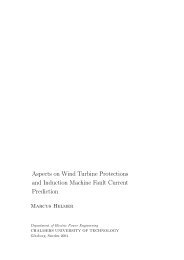

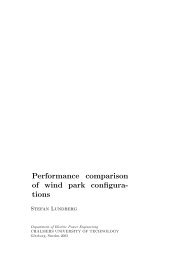
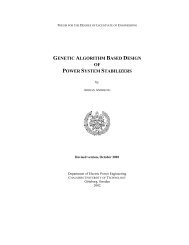
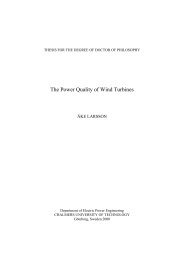
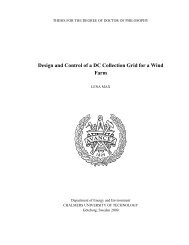


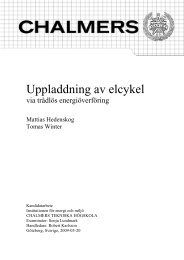

![LAPLACE OPERATOR.ppt [Lecture seule]](https://img.yumpu.com/42909900/1/190x135/laplace-operatorppt-lecture-seule.jpg?quality=85)

